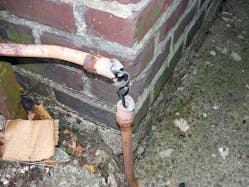How well do you know the Code? Think you can spot violations the original installer either ignored or couldn't identify? Here's your chance to moonlight as an electrical inspector and second-guess someone else's work from the safety of your living room or office. It's your turn to identify the violation.
Hint: The incredible invisible box
Find the Answer
Metal raceways and metal enclosures for conductors must be metallically joined together to form a continuous electrical conductor. With this broken conduit body, the circuit has lost continuity for its only equipment grounding conductor (i.e., the rigid metal conduit).
This creates a violation of Sec. 300.10 of the 2014 NEC and could potentially create a dangerous shock hazard if the equipment is not properly bonded and grounded as required by Art. 250. Section 250.96(A), for example, requires metal raceways, enclosures and other metal non-current-carrying parts serving as equipment grounding conductors, to be bonded to ensure electrical continuity — and to safely carry any fault current imposed on them.
The broken conduit body also creates a violation of Sec. 110.12(B), since damaged, broken, bent, cut, or deteriorated parts that adversely affect the safe operation or mechanical strength of the equipment are not permitted. The exposed wires are no longer being protected by the raceway and enclosure, and the jagged edges of the broken metal could easily cause the insulation on the wires to get nicked or cut, or damaged from exposure to the weather. This could create a fire or shock hazard. This conduit body needs to be replaced in order to return this circuit to a Code-compliant condition.





